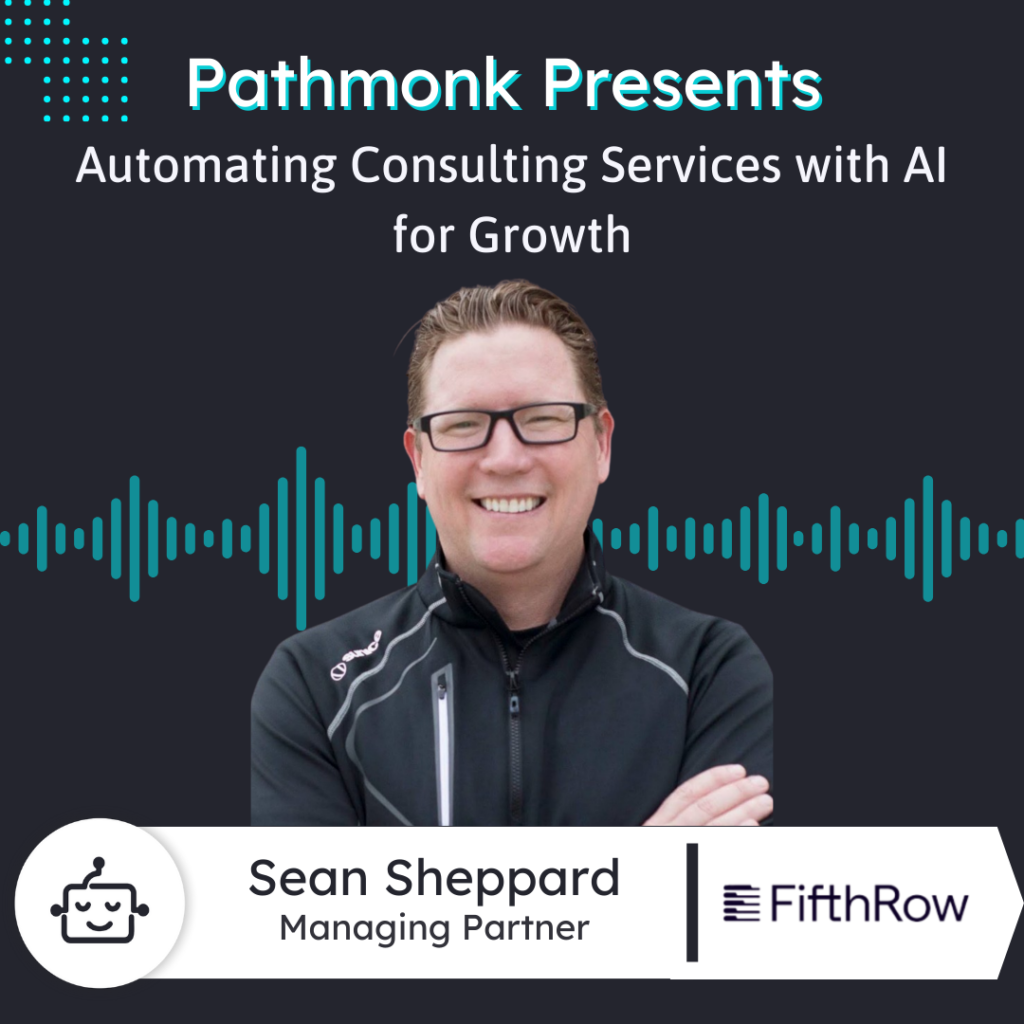
Introduction
In this episode of Pathmonk Presents, we interview Sean Sheppard, Managing Partner at FifthRow, about how their AI-driven platform is transforming the consulting industry.
FifthRow leverages no-code tools and autonomous agents to automate up to 80% of tasks traditionally done by consultants, including market research, strategy development, and customer validation. Sean shares insights on predictive company building, creating scalable business models, and how AI is reshaping corporate innovation.
Tune in to learn how businesses can shorten timelines, reduce costs, and uncover new revenue opportunities with cutting-edge AI solutions.
Increase +180%
leads
demos
sales
bookings
from your website with AI
Get more conversions from your existing website traffic delivering personalized experiences.

Rick Veronese: Pathmonk is the AI for website conversions. With increasing online competition, over 98 percent of website visitors don’t convert. The ability to successfully show your value proposition and support visitors in the buying journey separates you from the competition online. Pathmonk qualifies or converts leads on your website by figuring out where they are in the buying journey and influencing them in key decision moments with relevant micro experiences like case studies, intro videos, and much more. Stay relevant to your visitors and increase conversions by 50%. Add Pathmonk to your website in seconds, let the artificial intelligence do all the work, and increase conversions by 50 percent while you keep doing marketing as usual. Check us out on Pathmonk.com.
All right, everyone. Welcome to today’s episode of Pathmonk Presents. And let’s talk about today’s guest. We have Sean from Fitthrow, the managing partner of this amazing company that helps you turn your consulting service into software. Good to have you on today’s show, Sean. How’s it going?
Sean Sheppard: Glad to be here, Rick. Doing great.
Rick: Amazing. Sean, I just gave the briefest description anyone can think about for Fitthrow, but myself and the audience want to hear from you. In your own words, what’s the heart of what Fitthrow does, and how would you describe it to someone new?
Sean: Yeah, we are going after the $5 trillion management consulting industry to try and automate as much of it as we can using AI in the form of autonomous agents. You can rapidly build applications, in a no-code fashion, to deploy autonomous agents to replace the work of management consultants.
Whether it’s research, strategy, design, market testing and validation, or business model concept creation, we started in the venture-building arena because that’s where we were before, when we were U Plus. We built over 130 digital businesses for large enterprises globally.
When Gen AI came out a couple of years ago, we decided to figure out how to cannibalize our own business because we knew if we didn’t do it, someone else would. We’ve been live with paying customers for about a year, growing 20 percent month over month. It’s doing 80 percent of the work that management consultants used to do, particularly lower-level analysts and researchers in innovation teams, product teams, market intelligence teams, and consumer insights teams.
Rick: Very interesting. I’ve worked as a design consultant for quite a while, and I’ve always found myself in that predicament where you want to productize your service, but so many components come with it. Something like this would have helped a lot back in the day. I’m also curious—what kind of businesses or consultants do you work with? Who do you feel you’re able to serve best at this point?
Sean: Since we come from the venture-building and innovation space, we started in that vertical, but we’re quickly advancing into a wide variety of verticals. Any human service that can be automated, we’re trying to automate.
Our early customers are existing venture-building clients. We’re taking a process that used to take six months and cost half a million dollars and getting it down to a couple of weeks and tens of thousands of dollars. At scale, we can ideate, develop business model propositions, test and validate them, and predict demand before we invest heavily in any idea.
We’re also partnering with professional services organizations who see a similar future for themselves. A significant portion of their work will be replaced by AI, allowing them to focus on high-value tasks like creative thinking, strategy, and insights.
Rick: That sounds very appealing. What’s “predictive company building”? Can you tell me a little more about what that consists of?
Sean: Predictive company building involves taking an idea, assessing if it’s big enough and aligned with a company’s strategy and assets, and testing it with customers before heavy investment.
We can generate ideas in a market space in hours, align them with a company’s corporate strategy, and test them using microsites and multivariate testing. We benchmark these results against industry averages to predict demand.
When we did this as a physical service, we achieved a 30-35 percent success rate with ideas we tested in the market. With AI, we’re now at 82 percent. We get better insights, data, and structured approaches to create differentiation in the market.
The AI automates everything: microsites, messaging, ad copy, campaign channels, buyer personas, customer journey maps, and MVP scoping. It allows us to create business cases with speed and accuracy.
Rick: Very interesting. Let’s say I’m in need of this kind of automation, which I might be—how would I find out about you? What acquisition channels do you use?
Sean: FifthRow.com is the best place to learn more and get a demo. Our customer segments range from solopreneurs using it for $400 a month to enterprises spending half a million to a million annually to replace traditional consulting firms.
We also use LinkedIn, outbound email campaigns, webinars, and conferences to target innovation and strategy professionals. Once clients start using our services, they see the wide variety of use cases across their teams, from product development to growth marketing.
Rick: What role does your website play in attracting clients? Any standout strengths or areas to improve?
Sean: In enterprise B2B marketing, the website isn’t as critical as it would be in a B2C touchless sales environment, but it’s still vital. It has to educate customers, showcase your value proposition, and build trust through thought leadership and case studies.
Roughly 70 percent of the sales cycle in B2B is done before customers contact you, so your website should be a hub for answering their questions and nurturing them closer to a decision.
Rick: That’s a good point. It seems like your website is more about enabling education and nurturing potential clients rather than being the sole driver of conversions. It’s interesting how much content plays a role in that. Speaking of content, are there any specific tools or approaches that, in your experience, make a great converting website?
Sean: Definitely. I’m a big fan of tools that allow for rapid experimentation. One of my favorites is Maestrics AI—it helps you conduct experiments at scale for websites and marketing channels. Of course, tools like Hotjar are also great for gaining insights into user behavior.
But honestly, I’m big on human-to-human interaction. Conducting live customer interviews to test website hypotheses or gather feedback has been invaluable for us. It helps refine the user experience and content strategy to better serve the needs of our target audience.
Rick: That’s a really personal approach, which I think many companies overlook. Now, switching gears a little, I’d like to talk about you as a leader. What does a typical day look like for you? What are some key tasks you focus on as managing partner at Fitthrow?
Sean: My primary focus is creating leverage through people and capital. My job is to ensure my team has the tools, resources, and direction they need to succeed while also driving growth through revenue and funding.
Every day, I ask myself: “Am I advancing the ball in these areas?” Whether it’s helping the team create value for customers, aligning our strategy with market needs, or fostering a culture of learning and innovation, I prioritize activities that drive momentum.
For me, it’s all about stacking productive days. Consistency and discipline in small, daily wins lead to long-term success.
Rick: That’s a great way to put it—stacking productive days to build momentum. It sounds like you’ve really honed in on that balance between team support and strategic growth. We’re nearing the end of the interview, so I want to jump into our rapid-fire questions. The only rule: short and crisp answers. Are you ready?
Sean: Ready.
Rick: Video or text?
Sean: Video.
Rick: What’s the most recent video you watched, and why did it stick with you?
Sean: I’m a big fan of stoicism, so it was a video by Ryan Holiday. It stuck with me because stoicism provides a great framework for managing emotions and maintaining perspective, especially in the chaos of entrepreneurship.
Rick: If there were no limits with technology, what’s one thing you’d love to solve as a leader?
Sean: Mental health in organizations.
Rick: If you could automate one thing you find yourself doing over and over again, what would it be?
Sean: Counseling people.
Rick: What’s one piece of advice you’d give yourself if you were to restart your journey tomorrow?
Sean: Trust my gut. Your body tells you things for a reason—listen to it.
Rick: That’s powerful advice. Before we wrap up, I want to give you the final word. If someone forgets everything about today’s interview, what’s the one thing they should remember about Fitthrow?
Sean: From a marketing perspective, your job is to share your worldview with those who agree with you and ignore those who don’t. Focus your energy on the ones who care about what you’re doing.
Rick: That’s an incredible takeaway. Sean, thank you so much for joining us today. I hope we can connect again soon.
Sean: Thank you, Rick. It’s been a pleasure.
Rick: Thanks, everyone, for tuning in. See you next time!











